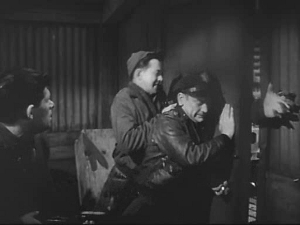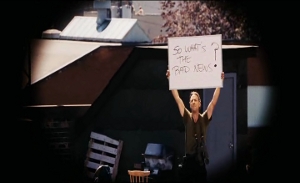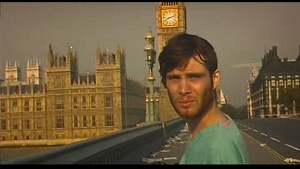All posts by David DeMoss
Trash Culture’s Ninja Turtles Rip-offs, Case Study #3: Battletoads
by Chad Denton
Technically Battletoads counts as a Teenage Mutant Ninja Turtles knock-off, but still it’s one that managed to become something entirely in its own right. Battletoads is rightly remembered as one of the best games in the history of the Nintendo Entertainment System, a game that starts off as a slightly off-kilter beat-’em up but then goes through an amazing array of stages and challenges that made it feel like at least several different good (if hard as hell) games in one. It says a lot about the quality and creativity of the game that it’s considered a classic in spite of the fact that it’s so frustrating it tests the limits of human reaction times, as anyone who survived the obstacle course race levels can tell you.
Continue reading Trash Culture’s Ninja Turtles Rip-offs, Case Study #3: Battletoads
All-Star Superman (2011)

Every once in a not-so-great while, comic book companies decide to annihilate decades of established continuity and set their famous characters back to Year Zero in the name of attracting new readers. Such publicity stunts will inevitably antagonize existing fans whose bad word of mouth will (theoretically) scare away those coveted new readers. So it was that, sometime around 1998, Scottish comics writer Grant Morrison teamed up with other Big Name writers Mark Waid, Mark Millar and Tom Peyer to pitch a complete revamp of Superman.
“We believe that the four of us understand the new face of Superman: a forward-looking, intelligent, enthusiastic hero retooled to address the challenges of the next thousand years. The ultimate American icon revitalized for the new millennium as an aspirational figure, a role model for 21st Century global humanity.
“The Superman relaunch we’re selling bucks the trend of sweeping aside the work done by those who came immediately before. Unlike the ‘cosmic reset’ revamps all too prevalent in current comics, our New Superman approach is an honest attempt to synthesize the best of all previous eras. Our intention is to honor each of Superman’s various interpretations and to use internal story logic as our launching pad for a re-imagined, streamlined 21st century Man of Steel.” Continue reading All-Star Superman (2011)
The Thing from Another World (1951)

In 1951, science fiction movies took two booster shots to the arm and entered into the public consciousness on a scale so grand that, looking back on it now, it’s like watching a dam burst in slow motion. So much so that one can easily drown in the torrent of “creature features” America produced in the 1950s. All thanks to two films that defined the boundaries of their sub-genre, enlivening hoary old tropes by dragging them, kicking and screaming, into the twentieth century.
One of those films, which we’ll consider in its own time, was The Day the Earth Stood Still. The other, released five months before, was The Thing from Another World. You can try and find a stranger pair of siblings…but I don’t really want you too. These two are all I need because they were all the genre needed at the time.
Prior to their release, science fiction was a joke, laughed at and bemoaned in turn by polite society, allowing it to become the sole province of nerds. The Thing irrevocably welded Sci-fi to Horror and saved both genres from their separate decline into self-parody and stupidity…as evidenced by another “great” film from 1951, Abbot and Costello Meet the Invisible Man. The world was six years away from Hiroshima and Nagasaki and the old monsters had lost their grip on the collective amygdilla. New monsters – in a comfortably Frankenstein-ish mode, to be sure, but still – were already moving back in the shadows, ready to pop through the first conveniently open door and take your head off with a casual swipe. Continue reading The Thing from Another World (1951)
Trash Culture’s Dr. Who Reviews – The Dalek Invasion of Earth (1965)
by Chad Denton
Ian and Barbara are overjoyed that this time the TARDIS landed near a pier on the Thames in modern London – or so it appears. Their glee turns to trepidation when they find that even though they’re clearly in London there’s no one around, the city is quiet, and their surroundings are decrepit. Susan climbs a wall to look at the street above, causing the decaying structure to collapse, twisting Susan’s ankle and burying the TARDIS under debris just as Barbara and Ian realize they’re actually not at the right London. A furious (and frightened) Doctor and Ian go to a nearby warehouse to look for tools to dig up the TARDIS. While tending to Susan’s ankle, Barbara notices a poster on a wall that reads, “IT IS FORBIDDEN TO DUMP BODIES IN THE RIVER” while at the warehouse Ian sees a calendar marking the year as 2164. A young man, who turns out to be named Tyler, comes across Barbara and Susan. Apparently shocked to see them, he demands that they come with him, going so far as grabbing Susan and carrying her. Barbara reluctantly follows. Back at the warehouse the Doctor and Ian stumble across the corpse of a man wearing an elaborate metallic helmet. The Doctor is curious about what kind of catastrophe befell London, while Ian, naturally, just wants to get back in the TARDIS. As they leave, they spot a flying saucer descending into London. Continue reading Trash Culture’s Dr. Who Reviews – The Dalek Invasion of Earth (1965)
M.A.N.T.I.S. (1994)
Zombie vs. Ninja (1988)

Sorry it’s taken me this long to talk about Godfrey Ho, but the task is somewhat daunting. Man’s got twenty-five years worth of movies on his resume, with over a hundred credited titles to chose from. Some are almost decent. Some are so bad they’ve redefined “bad Hong Kong action movie” for an entire generation. And some are so weird you’ll wonder if you ever saw them in the first place. One of those is Zombie vs. Ninja.
There are cheap bastards and then there are cheap bastards, but even the cheapest, most miserly Scrooge in Charles Dickens’ notebook would stand in awe of Godfrey Ho’s filmmaking techniques. Ho liked to take the money most people would use to shoot a movie, shoot half of a movie, and then splice that half together with incomplete films he found moldering in Hong Kong studio basements. Or foreign films bought up cheap from Thailand, the Philippines, or South Korea. This ensured Ho could make two, three, sometimes even four films for the price of one. He made no promises about their overall quality. And neither do I. Continue reading Zombie vs. Ninja (1988)
Trash Culture’s Dr. Who Reviews – Planet of the Giants (1964)
by Chad Denton
Well, we’ve made it to the second season, so let’s get started with a serial whose premise also became a level in “Super Mario Bros. 3?…
As the TARDIS lands in what the Doctor assures Barbara and Ian is their native time, something malfunctions and the Doctor panics. When they try to view what’s outside, the scanner breaks. Outside they’re puzzled by what seems to be a stone monument shaped like a massive pebble. Splitting up to investigate further, Susan and Ian find a dead ant the size of a cat while the Doctor and Barbara find a gigantic earthworm that’s also dead. Soon Ian and Susan also find a large box of stock (that is, the broth kind, not the finance kind) that was manufactured in Norwich. Simultaneously the Doctor and Susan realize that the TARDIS and they as well have become smaller than an inch. Continue reading Trash Culture’s Dr. Who Reviews – Planet of the Giants (1964)
Dawn of the Dead (2004)

The original Dawn of the Dead was twenty-six years old by the time this remake entered the pipeline. Its time had very much come and, in one sense, already gone. Tom Savini’s 1990 Night of the Living Dead remake celebrated its sweet sixteen by the time 28 Days Later broke out of its “low” budget genre ghetto, made it to Sundance, eventually broke out of that ghetto, too, and became a critical darling and smash hit…for whatever reason.
I try to ignore Spring horror films as much as I can because they tend to suck as a rule. (A popular example from the year in which I write – 2011 – would be the Scott Charles Stewart directed Paul Bettany vehicle, Priest.) January and February are studio dumping grounds for sub-standard, shitty movies they know no one will want to see. By March they’ve usually worked through the previous year’s back catalog and begun to ship out films designed specifically for home markets. Christ’s sake, no one really wants to watch big budget horror movies in March…but March is only seven months away from Halloween. Time enough for a film (like this one, which “only” cost $28 million) to earn its money back in theaters, allowing ancillary sales (like seasonally-appropriate DVDs and TV broadcast rights) to count as pure profit.
Predictably, this movie became the early breakout hit of 2004. Not that anyone at Universal actually predicted that. They were convinced the complete failure of 2003’s House of the Dead meant no one really wanted to see any more zombie movies. (And as long as by “no one” they meant “me” that statement held true.) Anyone with a functional brain could’ve told them House of the Dead failed because of two key words: “Uwe” and “Boll.” Never the less, Universal cut every corner they could, going so far as to turn the cameras over to some jumped up car commercial director named Zack Snyder. Continue reading Dawn of the Dead (2004)
28 Days Later…(2002)

This is another one of those apparently genre-redefining films that all the first-run critics praised. Most of the genre critics have since torn this film apart, the better to examine its undigested stomach contents. I was going to do that, too. But my fellow Cold Fusioneer, MonsterHunter, already did. So go read it. It’s awesome. And it leaves me free to do my own damn thing.
As my colleague noted, George Romero’s Dawn and Day of the Dead played Alex Kintner here, inspirations director Danny Boyle rightly copped to early and often. He and I share a love for Day of the Triffids, and while he’s never mentioned Geoff Murphy’s The Quiet Earth (to my knowledge), I’ll bet we both watched that at some point in the mid-to-late-80s.
Boyle was directing TV movies at that time, a job designed to make people wish for some population-flattening apocalypse. Then he hit what he must’ve considered “the big time” with Trainspotting, a movie about Scottish heroin addicts so honestly well made even American heroin addicts managed to work up some small spark of interest in it. For a moment there in the early 2000s, Trainspotting became part of a Unholy Trinity of Awesome movies every member of my small, real-world-based subculture championed, whether they liked talking about movies or not. Most didn’t, but I kept my ear to the ground and eventually rumors swirled that the guy who did Trainspotting was making a zombie movie. How could that be anything less than awesome? Continue reading 28 Days Later…(2002)
